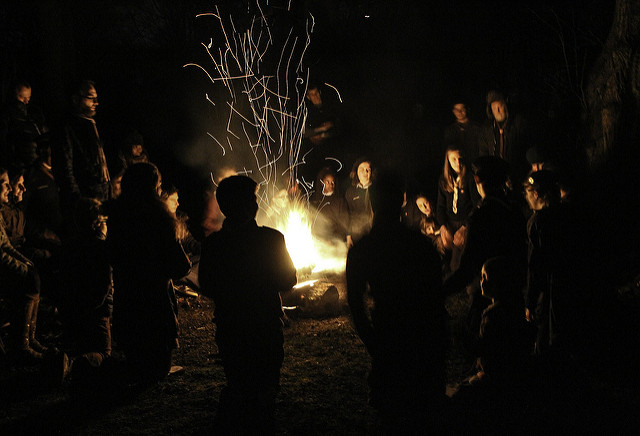Learning is a fantastically non-linear, subjective experience that is like a stream flowing over, around, and through any number of expected and unexpected obstacles. It’s midway through the semester, and always at this time of year I find myself reflecting on how and why, on visible and invisible progress, and on what my role as teacher and facilitator might be for my students. Yesterday I discussed the concept of ‘curriculum’ with a good friend and respected colleague, Kenn, and that conversation stuck with me. It stuck with me so much that I had to ‘sprout’ it. (See Geoffrey’s comment here for an explanation of ‘sprout’.) Kenn put forward the idea that anything could be strung together and called a curriculum, but it was important for that content to connect with the learner. He said one of my all-time favourites. You cannot make someone have a spark and be excited about something if an inkling of it isn’t there already.
He spoke about the nature of intrinsic motivation, and how if that ‘spark’ isn’t there, you can’t just throw it at someone and expect it to stick, like paint. But, if it is there, and I hope we all have at least one spark of passion to cultivate something deep within us. With sparks present, the teacher can metaphorically stoke the fire. You or I plan and lay the kindling to allow the air to flow, and when needed, get out the bellows to help puff the current.
Yes, connecting with that spark is so important.
From a teacher’s point of view that means I need to have an awareness of how, so that when I do lay the pieces out for the students, it guides. I likened it to driving the motor cars at Disneyland, with the metal guide rails at the side to keep people on the road. They are wide enough that you can veer to the left or right, but you can’t completely fall off. You can certainly receive a jolt as you bang into the rails, but you are safe and it would be pretty hard to fail completely. As a child I remember riding those cars and being so proud that I was the one driving. Guidance, yes. Safety rails, yes. Kenn reminded me that as the driver, that child or student, still has to put her foot down to make the car go. I did it. My students do it. The connection to the spark is so important.
When put in that car, with all the right guidance rails, and no spark, you still won’t fail. Why? Because  everyone follows one another, and most people want to be there. So if the person behind does put his foot down, then your car will lurch forward when his bumps into yours! Being vaulted from one place to the next is no way to learn. I am sure it does happen though – and there are better ways to not fail. I remember classes I might admit to having taken just because of requirements… and lurching from one assignment to the next simply to accrue the necessary points or credits. In those cituations I certainly didn’t learn anything by choice. If we as teachers can find a way to connect, then it makes all the difference. (image CC BY-NC by Thomas Hawk)
everyone follows one another, and most people want to be there. So if the person behind does put his foot down, then your car will lurch forward when his bumps into yours! Being vaulted from one place to the next is no way to learn. I am sure it does happen though – and there are better ways to not fail. I remember classes I might admit to having taken just because of requirements… and lurching from one assignment to the next simply to accrue the necessary points or credits. In those cituations I certainly didn’t learn anything by choice. If we as teachers can find a way to connect, then it makes all the difference. (image CC BY-NC by Thomas Hawk)
Answers?
I don’t have the answer to a golden curriculum, and I think that’s ok. It’s ok to admit as well. This semester my students create their own curriculum with #MUS654. We’ve been thinking about it this week. They set specific constraints for a single one-to-one setting. When you can define all the variables, it is easier, but things within the curriculum still change when put into practise in a live teaching situation. I certainly still actively search for answers (I think that’s also called learning!) and surely even when I think I have found a solution, it will change with each group of students, each changing year, each season. There are so many many variables that affect one’s learning and living that one size will never fit all. However, the good bits and the successful strategies will add to the repertoire and aspects of them will transfer to each new situation.
I commend to you this article by John Hattie and Gregory Donoghue
Learning strategies: a synthesis and conceptual model
It gives a model (like it says in the title) but more than that, it dissects the different stages of learning. It provides a very thought provoking discussion on those big questions of how and what we learn, why, and what is the value. The authors unpack surface learning and deep learning, and really discuss the ‘skill, will, and thrill’ of learning. I’m hoping to ‘think through’ this article as part of an annotation flashmob (hosted by Marginal Syllabus with Remi Kalir)
See what Remi says about the project here: http://marginalsyllab.us/info-updates/intro/
Featured image CC BY-NC-SA by Lawrence OP

I agree with Kenn. The student needs to have an initial spark to learning something. I can imagine it being hard to motivate or teach someone that doesn’t have the motivation to learn. I’ve experienced this as a student at school where I would watch some of the other students not taking an interest into what the teacher was teaching.
So many instrumental teachers, especially the ones who have taught me in the past and even mow at university, use the graded syllabi as a curriculum. And even once they or the student have chosen the pieces that will be played for the exam, the teacher then uses the syllabus to find more repertoire. I found that this very limiting and when I asked that I wanted different repertoire they kept telling me to look in the syllabus, this also makes it very boring for the student. I can understand why teachers would mainly use the syllabi; simple, easy, they know that the pieces are the appropriate level but this gives students a very close minded repertoire and experience. The only times I ever did anything different in lessons were when I took ‘fun’ music to the lesson.
I believe instrumental teachers need to be more imaginative and open up to other ways of teaching than just using the graded syllabi.